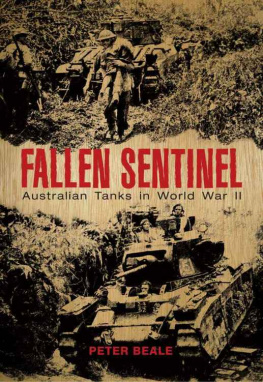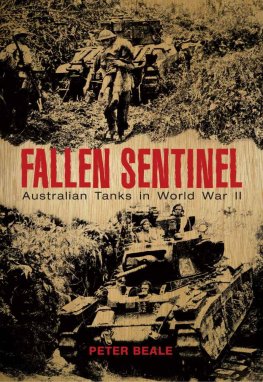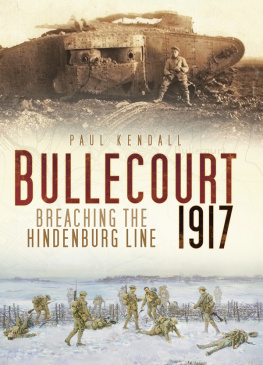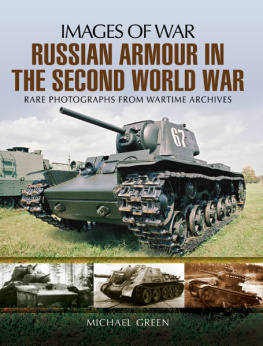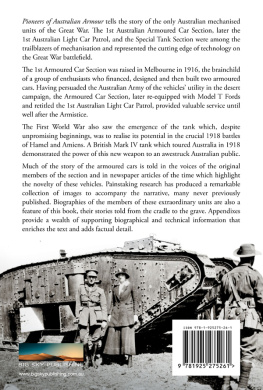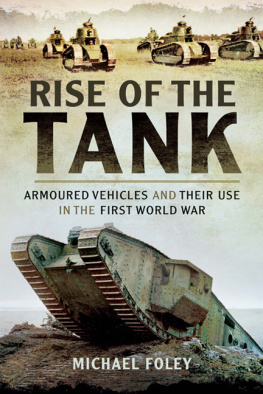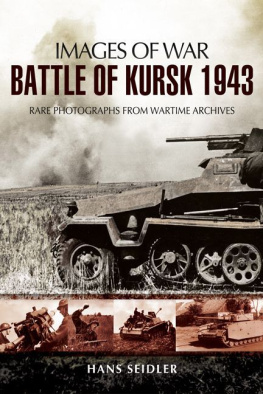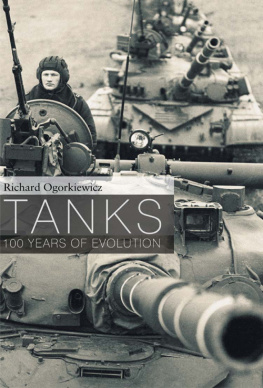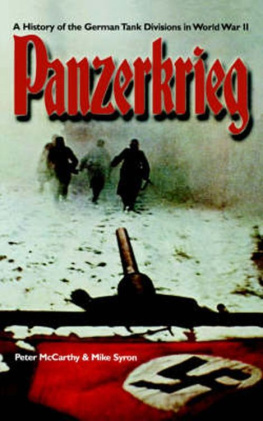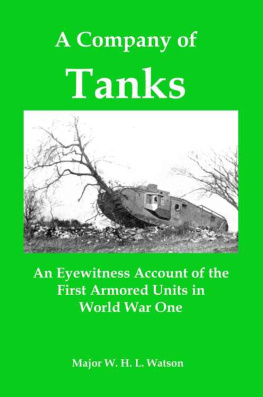
Australian Tanks in World War II

www.bigskypublishing.com.au

Australian Tanks in World War II

www.bigskypublishing.com.au
PETER BEALE
Copyright Peter Beale 2011
First published 2011
Copyright remains the property of the author and apart from any fair dealing for the purposes of private study, research, criticism or review, as permitted under the Copyright Act, no part may be reproduced by any process without written permission.
All inquiries should be made to the publishers.
Big Sky Publishing Pty Ltd
PO Box 303, Newport, NSW 2106, Australia
Phone: | (61 2) 9918 2168 |
Fax: | (61 2) 9918 2396 |
Email: | info@bigskypublishing.com.au |
Web: | www.bigskypublishing.com.au |
Cover design and typesetting: Think Productions
National Library of Australia Cataloguing-in-Publication entry
Author: Beale, Peter.
Title: Fallen sentinel : Australian tanks in World War II / Peter Beale.
ISBN: 9781921941023 (hbk.)
Notes: Includes bibliographical references and index.
Subjects: World War, 1939-1945--Australia--Tank warfare.
Tanks (Military science)--Australia--History.
Tank warfare--History.
Dewey Number: 358.180994
THE AUSTRALIAN ARMY HISTORY COLLECTION

Winning with Intelligence
Judy Thomas
Duntroon
Darren Moore
The Warrior Poets
Robert Morrison
The History of the Royal Australian Corps of Transport 19732000
Albert Palazzo
Defenders of Australia
Albert Palazzo
The Fight Leaders
D. Butler, A. Argent and J. Shelton
Operation Orders
Pat Beale
Little by Little
Michael Tyquin
Red Coats to Cams
Ian Kuring
Bowler of Gallipoli
Frank Glen
Vets at War
Ian M. Parsonson
Only One River to Cross
A.M. Harris
The Fragile Forts
Peter Oppenheim
Hassett: Australian Leader
John Essex-Clark
Persian Expedition
Alan Stewart
The Chiefs of the Australian Army
James Wood
Never Late
Gordon Dickens
To Villers-Bretonneux
Peter Edgar
Madness and the Military
Michael Tyquin
The Battle of Anzac Ridge 25 April 1915
Peter D. Williams
Doves Over the Pacific
Reuben R.E. Bowd
The Lionheart
David Coombes
Battlefield Korea
Maurie Pears
Chemical Warfare in Australia
Geoff Plunkett
A Most Unusual Regiment
M.J. Ryan
Between Victor and Vanquished
Arthur Page
Country Victorias Own
Neil Leckie
Surgeon and General
Ian Howie-Willis
Willingly into the Fray
Catherine McCullagh
Beyond Adversity
William Park
Crumps and Camouflets
Damien Finlayson
More than Bombs and Bandages
Kirsty Harris
The Last Knight
Robert Lowry
Forgotten Men
Michael Tyquin
Battle Scarred
Craig Deayton
Crossing the Wire
David Coombes
Do Unto Others
Alan H Smith
TABLE OF CONTENTS
PREFACE
The role of the tank in the First World War was clear. It was a recently developed weapon to crush barbed wire and knock out enemy strongpoints, particularly those containing machine-guns, and it achieved these two objectives successfully. By 1918 the performance of the heavy tanks had improved and was continuing to improve, and the lighter Whippet tank had also deployed successfully. The sudden end to the war on 11 November 1918 put tank development and the formulation of doctrine very much on hold.
This had two effects on the Tank Corps. The first was that resources to develop new tanks were very limited, and the second was that there was no opportunity to test changes to tank doctrine in real battles against hostile forces. Tank development went in all directions, and a large number of designs were proposed, many going no further than the drawing board. There were several views on the best way to use tanks, but evaluation was considerably hampered by uncertainty about the type of tank that would be available, a scarcity of resources to conduct exercises, and no opportunity for battle experience. Up to 1939 any formulation of tank doctrine by the Royal Tank Corps was purely theoretical.
Tank doctrine had to be learnt the hard way in World War II and, most of the time, it was unsuited to the reality of the war. Major General Pip Roberts served at many levels of armoured command after 1939. In 1944 he was commanding the 11th Armoured Division, and commented that it was not until the third battle in Normandy that they finally got the doctrine right. Illconsidered doctrine had resulted in the loss of many battles and the slaughter of tank crews and soldiers from the arms they were supposed to be supporting, particularly the infantry.
The Australian Armys experiences with tanks in the First World War were mixed: very bad at Bullecourt and good at Hamel and some later battles. Between the wars, the Australian tank arm was a very small component of the Army, and there was no officer of sufficient rank or experience to advise Army Headquarters concerning what could or should be done in respect of tanks.
This book traces the development of the Australian Armoured Corps, the design and production of its own Armoured Cruiser tank the Sentinel and the employment of tank units. It examines the projects to create an armoured division and build the Sentinel, both of which were slow in starting, but once commenced proceeded with exceptional speed and skill. As with all projects, timing is vital. Delay in starting may mean that the project outcomes are achieved too late to be of value.
The 1st Australian Armoured Division never saw action, and the Sentinel tank project was abandoned, even after some brilliant design and production efforts. There were several reasons for its abandonment, including the outbreak of war with Japan, the slow start to both projects, and the baleful influence of British tank doctrine. The question remains as to whether anything could have been done to prevent this waste of time and resources. A second, more pertinent issue concerns what the Australian Army has learned from this experience that will assist in the conduct of future operations. Answers to these questions form the central theme of this book.
ACKNOWLEDGEMENTS
On 5 May 2005 I was awarded a grant by the Australian Army History Unit (AHU) to produce a research paper An evaluation of the use of armoured forces by the Australian Army in World War II. My wife Shirley and I commenced research immediately and, later that year, presented a progress report to Roger Lee of the AHU. We were delighted when he offered us a contract to turn the research into a book to be published by the AHU.
We were able to concentrate almost full time on completion of the book, during which time we received help from many sources. These included the staff of the AHU and the staffs of the Australian War Memorial Research Centre and the National Archives of Australia. Christopher Dawkins at the Australian Defence Force Academy Library was a tower of strength, as was David Fletcher at the Tank Museum in Bovington. Lieutenant Colonel Todd Vail was particularly helpful in providing information about the procedures of the Australian Army, and Ric Pelvin and I journeyed along the lengthy process of editing together.
Next page
